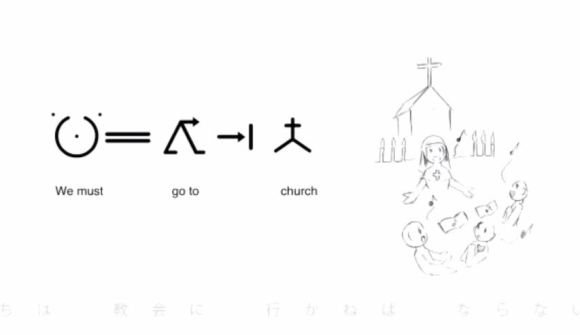
Yukio Ota is a legendary graphic designer in Japan. As the creator of the green “running man” pictogram that features on the nation’s emergency exit signs which have since spread to Europe, Canada and the Asia-Pacific, Ota is a frontrunner when it comes to developing images that convey a thousand words.
Now the designer of the exit sign is making headlines for his long-term project that aims to have the world using a universal language by 2065. Called the Lovers’ Communication System, or LoCoS, the standardised system based on pictographs has the power to overcome language barriers and revolutionise the world of communication as we know it.
Yukio Ota’s remarkable eye for imagery is clearly evident in his 1974 design for the emergency exit. As a pictogram that can be easily understood by anyone, regardless of nationality or language ability, the green “running man” became an international standardised image in 1987, meaning similar designs can now be seen in Europe, Canada and across the Asia-Pacific region today.

▼ In France, the design is slightly modified but remains equally effective.
▼ In Italy, the running man gets down low while running for the door.
イタリアの非常口の看板可愛い(笑) pic.twitter.com/h6Moz3hBoO
— ♡♡♡ MAI ♡♡♡ (@its__you) February 8, 2015
▼ In Turkey, there’s a sense of urgency that’s easily expressed without words.
https://twitter.com/chi3kai0/status/565432673167245313
▼ Ota also designed the logo for the Ministry of Economy, Trade and Industry.

The well-known pictogram for emergency evacuation areas in Japan is also Ota’s creation. While the sign played a big part in helping evacuees find shelter during the 2011 Tohoku earthquake and tsunami disaster, Ota believes the sign’s effectiveness could be enhanced even further. He’s currently working to incorporate the image on emergency lamps and fluorescent stickers to use on sidewalks and street poles to help guide people during night-time emergency situations.

With such a long and distinguished career in the field of pictogram design, it’s not surprising that Ota has a grand dream to see symbols and images being used to their fullest potential. His vision is for the world to be using a universal language by 2065; and he’s designed an innovative collection of images and symbols to help make this possible. Called LoCoS, which stands for “Lovers’ Communication System” as it’s designed to allow people to understand each other without words, like lovers do, the code has been in development for 30 years and is both easy to learn and fun to use.
Check out the video below for a comprehensive look at how the entire system works, from ‘words’ to sentence construction and even pronunciation. Could this be the international standard for communication in the future?
The basic pictographs used in LoCoS show us just how well-trained we are when it comes to understanding images without words. Today’s emoji-filled text messages have made us so adept at using pictogram-based systems, the below icons hardly need any explanation.
▼ From left to right: Plane, wine glass, fountain, rain, snow, wind, rainbow.
When it comes to constructing sentences, there’s a simple method to signify past, present and future tense.
▼ From left to right: To do; did; will do; to not do; didn’t do; will not do.
Combining the above tenses with a symbol gives us a simple sentence that’s quick to make and easy to understand.
▼ Clockwise, from top left: To see; to not see; didn’t see; won’t see; will see; saw.
Expanding on this simple structure allows for more complicated messages. And when it comes to pronunciation, there’s a method for that too, although it remains one of the more advanced levels of the system.
By combining the 18 consonants on the left of the picture below with one of nine positions from the vowel grid on the right, it’s possible to create a number of different pronunciations. The sound for a complete symbol is made from each of the symbols’ elements, which means the LoCoS pronunciation of the symbols for “entrance” and “house” are “hoipo” and “vaiho” respectively. Similarly, the name Ota can be constructed using two symbols (bottom right).
LoCoS certainly does have enormous potential to open up lines of communication between individuals and nations who would otherwise suffer a disconnect. Nothing will ever be able to replace the nuances and depth of understanding inherent in the written word, but as a halfway place between text and the common emoji, this pictorial language system is a pretty awesome substitute.
Source: Naver Matome
Top Image: Vimeo/whitescreenjp (edited by RocketNews24)
Insert Images: Vimeo/whitescreenjp (edited by RocketNews24)

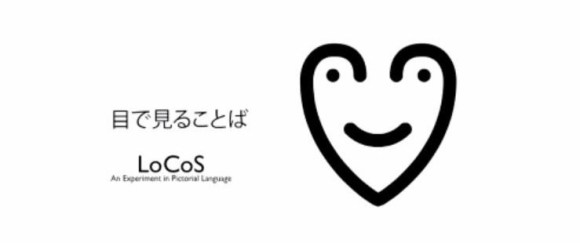
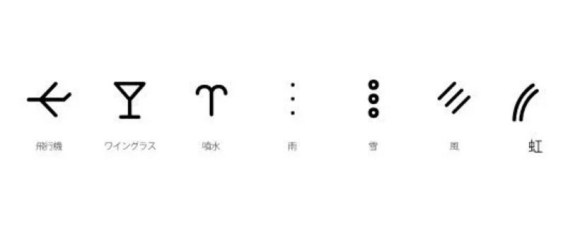
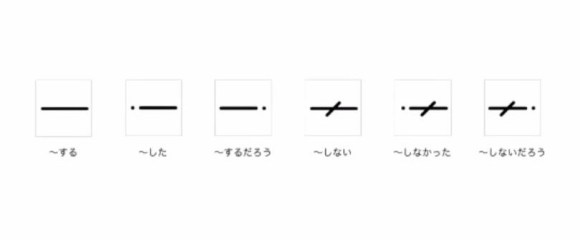
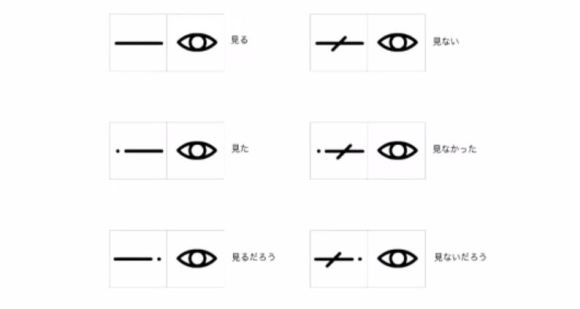

 Stylish new Experience Japan Pictograms are here to enhance your Japan travels and knowledge
Stylish new Experience Japan Pictograms are here to enhance your Japan travels and knowledge Anime’s impossible in real-life glasses now possible in real life, thanks to Japanese designers
Anime’s impossible in real-life glasses now possible in real life, thanks to Japanese designers Video explores fencing strikes and rules, looks super badass 【Video】
Video explores fencing strikes and rules, looks super badass 【Video】 Cosplay organization receives official government grant from Tokyo’s Ota Ward
Cosplay organization receives official government grant from Tokyo’s Ota Ward Japanese government recommends changing Buddhist temple mark on maps to avoid Nazi connotations
Japanese government recommends changing Buddhist temple mark on maps to avoid Nazi connotations Bad tourist manners at Mt Fuji Lawson photo spot prompts Japanese town to block view with screens
Bad tourist manners at Mt Fuji Lawson photo spot prompts Japanese town to block view with screens Foreigner’s request for help in Tokyo makes us sad for the state of society
Foreigner’s request for help in Tokyo makes us sad for the state of society McDonald’s Japan’s new pancake pie is a taste sensation
McDonald’s Japan’s new pancake pie is a taste sensation One of Japan’s oldest castles now lets travelers spend night on the grounds, drink in its keep
One of Japan’s oldest castles now lets travelers spend night on the grounds, drink in its keep FUK COFFEE?!? Japanese cafe has a perfectly innocent reason for its startling-looking name
FUK COFFEE?!? Japanese cafe has a perfectly innocent reason for its startling-looking name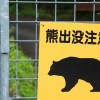 Bear attacks car in Japan, breaks windshield with its paw【Video】
Bear attacks car in Japan, breaks windshield with its paw【Video】 Studio Ghibli unveils massive T-shirt collection featuring top anime movie characters
Studio Ghibli unveils massive T-shirt collection featuring top anime movie characters Studio Ghibli unveils new goods that tip the hat to The Cat Returns
Studio Ghibli unveils new goods that tip the hat to The Cat Returns Japanese ramen restaurants under pressure from new yen banknotes
Japanese ramen restaurants under pressure from new yen banknotes Two things to do, and two things not to do, when leaving a traditional Japanese inn
Two things to do, and two things not to do, when leaving a traditional Japanese inn Red light district sushi restaurant in Tokyo shows us just how wrong we were about it
Red light district sushi restaurant in Tokyo shows us just how wrong we were about it McDonald’s new Happy Meals offer up cute and practical Sanrio lifestyle goods
McDonald’s new Happy Meals offer up cute and practical Sanrio lifestyle goods Tokyo Tsukiji fish market site to be redeveloped with 50,000-seat stadium, hotel, shopping center
Tokyo Tsukiji fish market site to be redeveloped with 50,000-seat stadium, hotel, shopping center Japanese city loses residents’ personal data, which was on paper being transported on a windy day
Japanese city loses residents’ personal data, which was on paper being transported on a windy day Beautiful Red and Blue Star luxury trains set to be Japan’s new Hokkaido travel stars
Beautiful Red and Blue Star luxury trains set to be Japan’s new Hokkaido travel stars Ghibli Park now selling “Grilled Frogs” from food cart in Valley of Witches
Ghibli Park now selling “Grilled Frogs” from food cart in Valley of Witches New definition of “Japanese whiskey” goes into effect to prevent fakes from fooling overseas buyers
New definition of “Japanese whiskey” goes into effect to prevent fakes from fooling overseas buyers Our Japanese reporter visits Costco in the U.S., finds super American and very Japanese things
Our Japanese reporter visits Costco in the U.S., finds super American and very Japanese things All-you-can-drink Starbucks and amazing views part of Tokyo’s new 170 meter-high sky lounge
All-you-can-drink Starbucks and amazing views part of Tokyo’s new 170 meter-high sky lounge More foreign tourists than ever before in history visited Japan last month
More foreign tourists than ever before in history visited Japan last month New Pokémon cakes let you eat your way through Pikachu and all the Eevee evolutions
New Pokémon cakes let you eat your way through Pikachu and all the Eevee evolutions Disney princesses get official manga makeovers for Manga Princess Cafe opening in Tokyo
Disney princesses get official manga makeovers for Manga Princess Cafe opening in Tokyo We try out “Chan Ramen”, an underground type of ramen popular in the ramen community
We try out “Chan Ramen”, an underground type of ramen popular in the ramen community Sales of Japan’s most convenient train ticket/shopping payment cards suspended indefinitely
Sales of Japan’s most convenient train ticket/shopping payment cards suspended indefinitely Sold-out Studio Ghibli desktop humidifiers are back so Totoro can help you through the dry season
Sold-out Studio Ghibli desktop humidifiers are back so Totoro can help you through the dry season Japanese government to make first change to romanization spelling rules since the 1950s
Japanese government to make first change to romanization spelling rules since the 1950s Ghibli founders Toshio Suzuki and Hayao Miyazaki contribute to Japanese whisky Totoro label design
Ghibli founders Toshio Suzuki and Hayao Miyazaki contribute to Japanese whisky Totoro label design Doraemon found buried at sea as scene from 1993 anime becomes real life【Photos】
Doraemon found buried at sea as scene from 1993 anime becomes real life【Photos】 Tokyo’s most famous Starbucks is closed
Tokyo’s most famous Starbucks is closed One Piece characters’ nationalities revealed, but fans have mixed opinions
One Piece characters’ nationalities revealed, but fans have mixed opinions We asked a Uniqlo employee what four things we should buy and their suggestions didn’t disappoint
We asked a Uniqlo employee what four things we should buy and their suggestions didn’t disappoint Watch Kanto’s Strongest Italian Chef transform McDonald’s into fine cuisine!【Recipe】
Watch Kanto’s Strongest Italian Chef transform McDonald’s into fine cuisine!【Recipe】 Japanese cheater learns why you should never try to lie to your train otaku girlfriend
Japanese cheater learns why you should never try to lie to your train otaku girlfriend Japanese governmental employees in frantic pencil-shaving spree to meet city election day
Japanese governmental employees in frantic pencil-shaving spree to meet city election day Holy noodles! Japanese restaurant serves up some very unusual udon
Holy noodles! Japanese restaurant serves up some very unusual udon Daihatsu dealership takes down controversial tweet boasting that they like trees
Daihatsu dealership takes down controversial tweet boasting that they like trees I need gum, milk, and a verse of “Let It Go”: Special karaoke convenience store to open
I need gum, milk, and a verse of “Let It Go”: Special karaoke convenience store to open Starbucks Japan releases beautiful sign-language mug at its first sign-language branch in Tokyo
Starbucks Japan releases beautiful sign-language mug at its first sign-language branch in Tokyo Three Tokyo youths arrested for cork hunting, everyone else learns what cork hunting is
Three Tokyo youths arrested for cork hunting, everyone else learns what cork hunting is What’s the real meaning of Japan’s “burning tofu” emoji?
What’s the real meaning of Japan’s “burning tofu” emoji? English conversation school in Japan has clever reminder that students don’t have to be perfect
English conversation school in Japan has clever reminder that students don’t have to be perfect Japanese flutist keeps her cool, plays beautifully even with a butterfly crawling across her face
Japanese flutist keeps her cool, plays beautifully even with a butterfly crawling across her face The blood-soaked meaning behind the mysterious marks on the floor at Tokyo Station【Photos】
The blood-soaked meaning behind the mysterious marks on the floor at Tokyo Station【Photos】 70 Japanese students volunteer to help clean Canada’s shores of Tohoku Tsunami debris
70 Japanese students volunteer to help clean Canada’s shores of Tohoku Tsunami debris Flush your prayers down the toilet at this unique Japanese temple
Flush your prayers down the toilet at this unique Japanese temple A guide to public bathhouses, the newest hot spot for tourists in Tokyo
A guide to public bathhouses, the newest hot spot for tourists in Tokyo
Leave a Reply